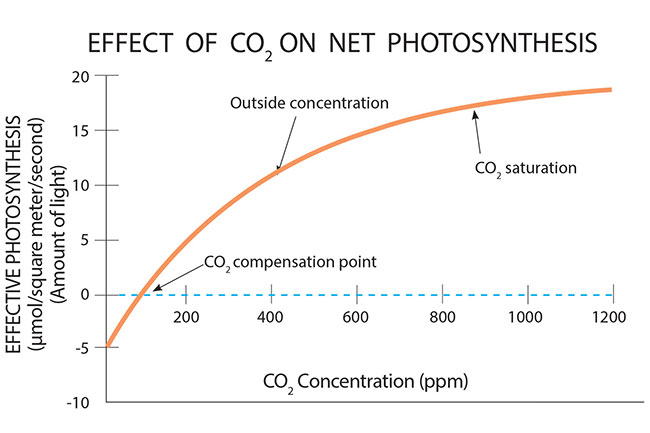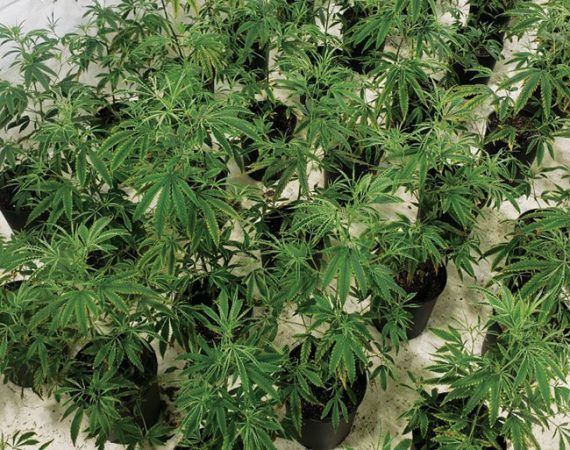
Features
Cultivation
Complying with the rules of cannabis photosynthesis
Understanding the role of CO2 and stomata is Part One of a series on plant science compliance
March 21, 2022 By Dr. Mohyuddin Mirza and Gagandeep Singh Bhatoa
 Figure 1
Photo: EdRosenthal.com
Figure 1
Photo: EdRosenthal.com Whether we grow indoors, in greenhouses, or outdoors in a field, growers are well aware of rules and regulations that we must comply with, and that we must keep all the records for audits. In the end, we get a sales licence.
This article focuses on the cannabis plant’s own rules and regulations that must be complied with. A cannabis plant is totally dependent on the grower for its optimum performance. While a grower may look to prioritize these physiological rules, experience has shown this may not be the best way to proceed, as cannabis plants perform best based on a totally holistic or integrated approach.
If any one of the plant’s needed rules and regulations aren’t followed, the plant’s performance is hindered and consequences will be serious.
Understanding photosynthesis
Cannabis, like other plants, is designed to fix light energy, (photons), in a biochemical form. To do so, the plant needs carbon dioxide and water. This is known as photosynthesis. Under cannabis rules, light, water, and carbon dioxide must be provided in proper proportions, at the right time. For example, a grower tried to push the crop by providing CO2 evduring the dark/night period. It violated the principle of not using CO2 during the dark period, and plants suffered.
6CO2 + 6H2 O + light energy = C6H12O6 + 6O2
This formula’s process is carried out in the leaves with green colour (the pigment chlorophyll), and several laws of physics, chemistry, and biology are involved. Inside the leaf there are chloroplasts, where all these reactions are carried out. Here are the key points to understand the above fundamental equation.
The importance of CO2 for photosynthesis
The rule of the plant is ensuring there’s enough carbon dioxide surrounding the leaves. Cannabis uses CO2 in the presence of light, which is also critical for photosynthesis. Cannabis plants suffer if they don’t get at least a minimum amount of CO2. Increasing the CO2 concentration beyond that, without increasing light intensity, doesn’t result in a higher rate of photosynthesis. The cannabis plant cannot benefit from higher CO2 levels until the light intensity increases.
At a light intensity of 600 mol (4,600 fc) (49,310 lux), the photosynthesis rate increases as CO2 concentration is increased to 400 parts per million (ppm). However, the rate of increase declines a bit after that, but the photosynthesis rate continues to increase as CO2 levels reach 600 ppm.
The ambient air has around 400 ppm of carbon dioxide gas and when plants start using that, the level can drop rapidly to half of that rate in which state, plants will stop during the photosynthesis. The process of photosynthesis speeds up as the amount of CO2 in the air elevated, as long as there is enough light to power it. Photosynthesis slows to a crawl and virtually stops at a CO2 concentration of around 200 ppm, as given in Figure 1. In an outdoor situation, the ambient CO2 is not depleted because of constant air movement, however in greenhouses and indoor operations, additional CO2 has to be supplemented.
How much CO2 is enough?
How much CO2, is enough for your cannabis plant? At less than 100 ppm of CO2, photosynthesis does not take place and cannabis plants suffer a net loss of sugar due to respiration.
At 100 ppm CO2, respiration and photosynthesis are equal so there is no net loss or gain. At 400 ppm (the same as outside air) the photosynthesis rate increases quickly, as the CO2 levels rise.
The increase in photosynthesis is more moderate as the CO2 concentration climbs to 800 ppm. However, from 800 to 1,000 ppm, some growers think that more is better.
But, the plant’s rule is that over 1,000 ppm, the stomata may not fully open. Stomata on cannabis plants can be triggered to open as a direct response to adequate light so the plants can use the carbon dioxide during photosynthesis.
Safe CO2 for your cannabis plant
Is there a rule for where your cannabis plant’s CO2 should come from?
Yes, plants don’t respond well if open flames are burned inside a facility. Such CO2 burners have been seen in some facilities. These open burners can raise the temperature and could also add some pollutants like carbon monoxide, nitrous oxide, and other combustion products. These pollutants go against the cannabis plant’s rules. Liquid CO2 is preferable.

Figure 2
Photo: Mohyuddin Mirza
The needs of a stomata
A cannabis plant’s stomata must be open to absorb CO2 inside the leaf, so it can be transported to the site of photosynthesis.
Keeping the stomata open requires proper water and potassium. Too much air movement isn’t good for the plants as well. For the CO2 to be diffused into the stomata, the air around the leaf has to be stationary.
The stomata openings are found mainly on the underside of the leaves must be kept open during the light period, and that depends on proper watering in the root zone and adequate transpiration from the leaves.
Rules for stomatal opening are complex and contradictory demands are placed on them during the growth cycle; growers must understand them for proper functioning of the cannabis plant. Stomata are the regulator of water status inside the leaves.
For example, when light is ‘on’ (daylight, LED, or HPS lights), it signals to the stomata that it should start opening. If irrigation isn’t timed to coincide with the light, then the signal is not to open the stomata because there isn’t enough water.
Similarly, if the temperature is over 24 C or 25 C, the signal is to absorb and transport more water from the roots to the leaves, and the stomata will start closing to preserve the water inside the leaves.
Understanding the stomata is a fascinating aspect of production of cannabis, and it’s important to its functioning.
Figure 2 shows a plant expriencing water stress and potassium deficiency. Yellow spotting can be seen on edges of all the plants, leaf edges rolling inward due to high relative humidity and over-supply of carbon dioxide from an open burner, which caused some pollutants to damage the leaves. Many rules and regulations of the plant were violated.
Future articles will discuss rules and regulations which relate to water, light, nutrients, and how they can make buds bigger and more bioactive compounds.
Mohyuddin Mirza, PhD, is an industry consultant in Edmonton, Alta. He can be reached at drmirzaconsultants@gmail.com.
Gagandeep Singh Bhatoa is a scientific writer in Regina, Sask. Email him at gaganagrico@gmail.com
Print this page